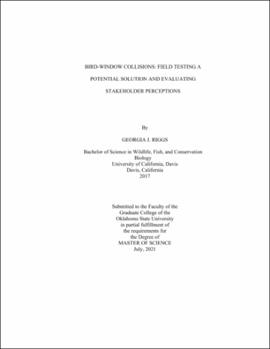| dc.contributor.advisor | Loss, Scott R. | |
| dc.contributor.author | Riggs, Georgia J. | |
| dc.date.accessioned | 2022-01-09T19:37:53Z | |
| dc.date.available | 2022-01-09T19:37:53Z | |
| dc.date.issued | 2021-07 | |
| dc.identifier.uri | https://hdl.handle.net/11244/333646 | |
| dc.description.abstract | Bird-window collisions are a major source of human-caused avian mortality for which there are multiple mitigation and prevention options available. Despite growing availability of products designed to reduce collisions, few replicated field tests have been conducted. Such tests are crucial to assessing effectiveness of products in real-world situations after installation on glass. The widespread adoption of available mitigation and prevention approaches, which is ultimately necessary to reduce bird-window collisions, also relies on understanding human perceptions. To address these research needs imperative to reducing this major source of avian mortality, we conducted two studies. | |
| dc.description.abstract | First, we conducted a well-replicated field study to evaluate the effectiveness of a commercially marketed product (Feather Friendly markers) in reducing bird-window collisions at glass-walled bus shelters in Stillwater, Oklahoma, USA. This study included a before-after control-impact (BACI) analysis comparing numbers of collisions at 18 bus shelters in both pre-treatment (2016) and post-treatment (2020) periods, and an analysis comparing 18 treated and 18 untreated shelters during 2020. Both analyses found that the treatment was highly effective and together, these analyses provide a rigorous field test of the effectiveness of this treatment option in reducing bird-window collisions. | |
| dc.description.abstract | Second, we investigated stakeholder perceptions and priorities related to bird-window collision mitigation and prevention. Specifically, we used a strengths, weaknesses, opportunities, and threats (SWOT) - Analytic Hierarchy Process (AHP) framework to learn more about the most effective ways to engage the public in helping to reduce bird-window collisions. Our results demonstrate that respondents from two stakeholder groups, homeowners and conservation practitioners, have an overall positive perception toward reducing bird-window collisions and that they believe the benefits of implementing mitigation and prevention techniques outweigh obstacles that may impede such measures. Our results indicate that the public may be receptive to education on this issue and that targeted and active education may be successful in garnering public support for and participation in bird-window collision mitigation and prevention. | |
| dc.description.abstract | Together, these two studies help make substantial progress in mitigating and preventing bird-window collisions. | |
| dc.format | application/pdf | |
| dc.language | en_US | |
| dc.rights | Copyright is held by the author who has granted the Oklahoma State University Library the non-exclusive right to share this material in its institutional repository. Contact Digital Library Services at lib-dls@okstate.edu or 405-744-9161 for the permission policy on the use, reproduction or distribution of this material. | |
| dc.title | Bird-window collisions: Field testing a potential solution and evaluating stakeholder perceptions | |
| dc.contributor.committeeMember | O'Connell, Timothy J. | |
| dc.contributor.committeeMember | Joshi, Omkar | |
| osu.filename | Riggs_okstate_0664M_17234.pdf | |
| osu.accesstype | Open Access | |
| dc.type.genre | Thesis | |
| dc.type.material | Text | |
| dc.subject.keywords | before-after control-impact | |
| dc.subject.keywords | bird collisions | |
| dc.subject.keywords | human dimensions | |
| dc.subject.keywords | stakeholder perceptions | |
| dc.subject.keywords | urban ecology | |
| dc.subject.keywords | window treatment | |
| thesis.degree.discipline | Natural Resource Ecology and Management | |
| thesis.degree.grantor | Oklahoma State University | |
